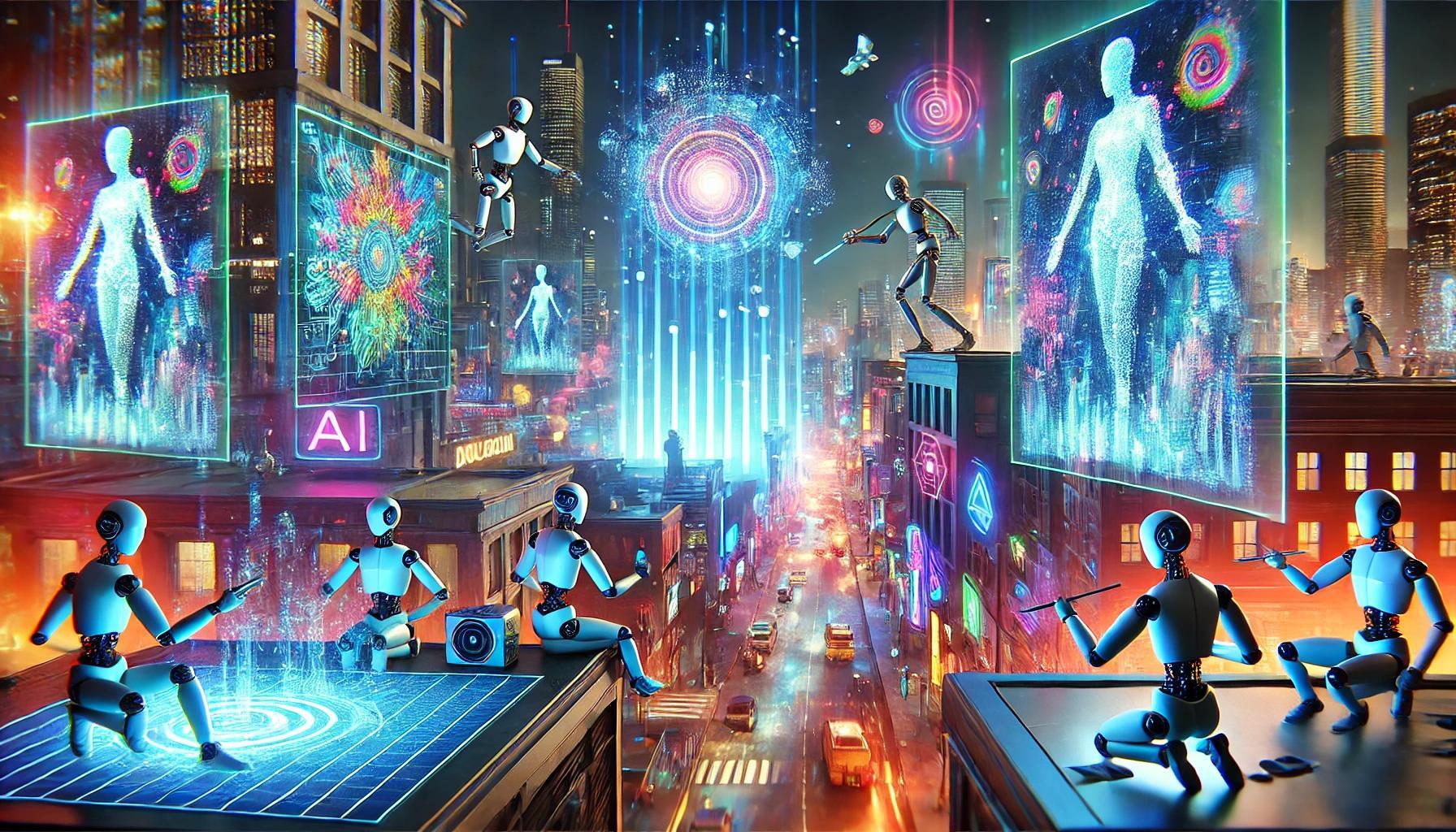
24 Mar AI-GENERATED CONTENT STATISTICS 2025
Artificial intelligence is reshaping how content is created, consumed, and distributed across industries. From marketing automation to academic research, AI-generated content is becoming increasingly prevalent, raising both opportunities and challenges. Businesses, educators, and policymakers are grappling with the implications of AI’s rapid adoption, particularly as it influences job markets, consumer trust, and digital interactions. As AI-generated media floods the internet, concerns over misinformation, authenticity, and ethical responsibility are growing. Meanwhile, AI’s ability to streamline workflows and enhance personalization continues to drive innovation in sectors like e-commerce, customer service, and education. Understanding the impact of AI-generated content requires examining key statistics and their broader implications. Amra and Elma gathers the following insights to highlight the most significant trends in AI-generated content, shedding light on how they will shape the future.
AI-GENERATED CONTENT STATISTICS 2025 (Editor’s Choice)
Artificial intelligence (AI) has significantly transformed content creation across various industries. Here are 20 notable statistics highlighting the impact and trends of AI-generated content, both historically and projected for 2025:
1. 71% of Social Media Images Are AI-Generated: As of March 2025, approximately 71% of images on social media platforms are created using AI technologies.
2. Deepfake Fraud Attempts Surge to 6.5%: The prevalence of deepfake-related fraud attempts has risen to 6.5%, underscoring the challenges in distinguishing authentic content.
3. AI to Contribute $15.7 Trillion to Global Economy by 2030: AI is projected to add $15.7 trillion to the global economy by 2030, reflecting its expansive influence across sectors.
4. 85 Million Jobs Displaced, 97 Million Created by 2025: By 2025, AI might eliminate 85 million jobs but create 97 million new ones, resulting in a net gain of 12 million jobs.
5. 78% of Marketers to Use AI Automation by 2028: Within the next three years, 78% of marketers plan to incorporate AI automation into more than a quarter of their tasks.
6. Generative AI Market Projected at $62.72 Billion in 2025: The generative AI market is expected to reach $62.72 billion in 2025, with a compound annual growth rate (CAGR) of 41.53% from 2025 to 2030.
7. 47% of U.S. Executives See AI Boosting Productivity: Nearly half of U.S. executives believe that generative AI will enhance productivity within their organizations.
8. 89% of Small Businesses Utilize AI Tools: A significant majority of small businesses have integrated AI tools to automate tasks and improve efficiency.
9. 8 Billion AI-Powered Voice Assistants by 2025: The number of AI-powered voice assistants in use worldwide is projected to reach 8 billion by the end of 2025.
10. 88% of Marketers Use AI in Daily Roles: A vast majority of marketers have incorporated AI into their daily activities, leveraging its capabilities for various tasks.
11. 68% of Service Professionals Use AI for Content Creation: Over two-thirds of service professionals employ AI for basic content creation and personalizing communications with customers.
12. 92% of Fortune 500 Companies Leverage OpenAI’s Technology: A vast majority of Fortune 500 companies are utilizing OpenAI’s technology to enhance their operations.
13. AI Market to Grow by 38% in 2025: The global AI market is anticipated to expand by 38% in 2025, indicating rapid adoption and integration across industries.
14. AI-Generated Content Comprises 99% of Internet Material by 2030: Projections suggest that by 2030, AI-generated content could constitute up to 99% of the internet’s material.
15. AI in Digital Commerce to Improve Customer Satisfaction by 25%: Businesses leveraging AI for digital commerce are expected to see over a 25% improvement in customer satisfaction.
16. AI-Generated ‘Slop’ Increasingly Populates the Internet: Concerns are growing over the proliferation of low-quality AI-generated content, often referred to as “slop,” affecting the quality of online information.
17. 92% of UK University Students Use AI Tools: A significant majority of university students in the UK have adopted AI tools to assist with their academic work.
18. AI-Generated Content Affects Search Engine Quality: The rise of AI-generated content has impacted the quality of search engine results, prompting adjustments in algorithms to prioritize authentic information.
19. AI Adoption in Customer Service Enhances Efficiency: Companies integrating AI into customer service report improved efficiency and better customer interactions.
20. AI-Powered Tools Assist in Academic Research: Researchers are increasingly utilizing AI-powered tools to aid in academic writing and data analysis, streamlining the research process.
These statistics underscore the pervasive influence of AI-generated content across various sectors, highlighting both the opportunities and challenges presented by this evolving technology.
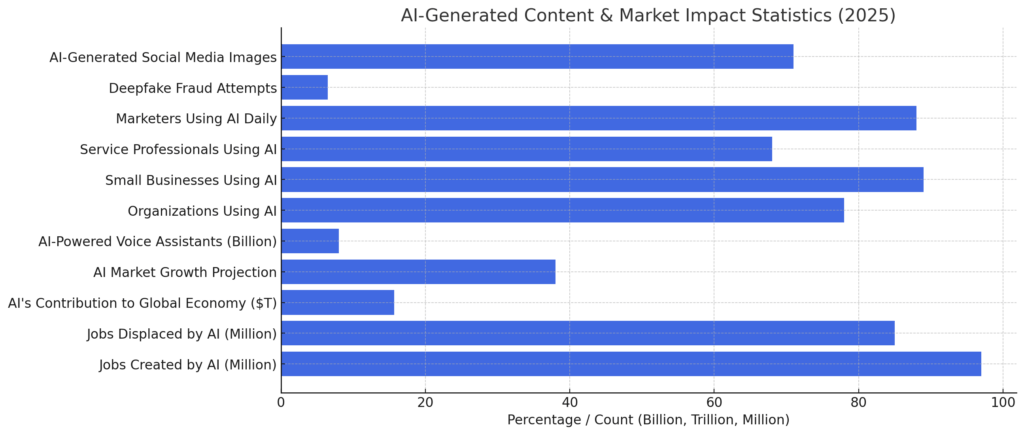
AI-GENERATED CONTENT STATISTICS 2025 and Future Implications
AI-GENERATED CONTENT STATISTICS 2025 #1. 71% of Social Media Images Are AI-Generated
The rise of AI-generated images on social media signals a shift in content creation, where digital influencers, brands, and individuals increasingly rely on automation to produce visuals. AI-powered tools like Midjourney, Stable Diffusion, and DALL·E make it easier to create hyper-realistic images tailored to specific audiences. This trend raises concerns about authenticity, as AI-generated visuals can blur the lines between reality and fabrication. It also challenges traditional graphic designers and photographers, pushing them to adopt AI tools or risk obsolescence. Social media platforms may need stronger policies to differentiate AI-generated content from human-made media to prevent misinformation. As AI continues to improve, its ability to generate content indistinguishable from reality could redefine advertising and entertainment. In the future, brands might create fully AI-generated models and influencers, eliminating the need for human talent in certain campaigns.
AI-GENERATED CONTENT STATISTICS 2025 #2. Deepfake Fraud Attempts Surge to 6.5%
The increasing use of deepfakes in fraud poses a growing cybersecurity threat, particularly in identity theft, political misinformation, and financial scams. With AI improving voice and video replication, attackers can impersonate executives, celebrities, or even everyday individuals with alarming accuracy. This trend underscores the need for stronger verification measures, including biometric authentication and AI-powered deepfake detection. Social media platforms and news organizations must adapt quickly to prevent manipulated media from spreading misinformation. Legal frameworks will also need updates to address liability and consequences for those creating harmful deepfake content. While AI-generated media can be used for legitimate purposes like film production and entertainment, its misuse is a serious concern. The future of online trust will depend on our ability to stay ahead of fraudulent AI-generated content.
AI-GENERATED CONTENT STATISTICS 2025 #3. AI to Contribute $15.7 Trillion to Global Economy by 2030
AI’s economic impact is expected to surpass the GDP of some of the world’s largest economies, fundamentally reshaping industries. Automation, data analysis, and AI-driven decision-making will boost efficiency in sectors like healthcare, finance, and manufacturing. However, this shift will also require a massive workforce adaptation, with demand for AI-related skills increasing. Nations investing in AI development will likely see accelerated economic growth, while those slow to adopt could face competitive disadvantages. This transformation could also deepen economic inequality if AI benefits remain concentrated among a few major corporations. Governments will need to balance innovation with policies that support displaced workers. If implemented responsibly, AI’s contribution to the economy could lead to unprecedented global prosperity and job creation in emerging tech fields.
AI-GENERATED CONTENT STATISTICS 2025 #4. 85 Million Jobs Displaced, 97 Million Created by 2025
While AI-driven automation will eliminate millions of jobs, it will simultaneously create new ones in fields like AI development, cybersecurity, and data science. The key challenge will be reskilling workers to transition into these emerging roles. Businesses that proactively invest in workforce training will be better positioned to adapt to AI-driven changes. However, the speed at which automation replaces jobs may outpace retraining efforts, leading to short-term unemployment spikes. Governments and educational institutions will need to implement large-scale reskilling initiatives to bridge the gap. Societies that embrace lifelong learning and AI literacy will fare better in this transformation. In the long run, AI has the potential to create a more efficient and innovative workforce, but only if adaptation efforts keep pace with technological advancements.
AI-GENERATED CONTENT STATISTICS 2025 #5. 78% of Marketers to Use AI Automation by 2028
AI-driven marketing automation is set to revolutionize how businesses interact with consumers, streamlining content creation, personalized recommendations, and customer engagement. Chatbots, predictive analytics, and AI-generated copywriting will allow brands to scale their marketing efforts efficiently. However, overreliance on AI could lead to generic, impersonal interactions that reduce brand authenticity. The challenge for marketers will be finding the balance between AI efficiency and human creativity. Companies that effectively integrate AI while maintaining a personal touch will have a competitive advantage. Ethical concerns regarding data privacy and AI bias will also shape how businesses use automation tools. In the future, AI may enable fully autonomous marketing campaigns, but human oversight will remain essential for strategy and ethical considerations.
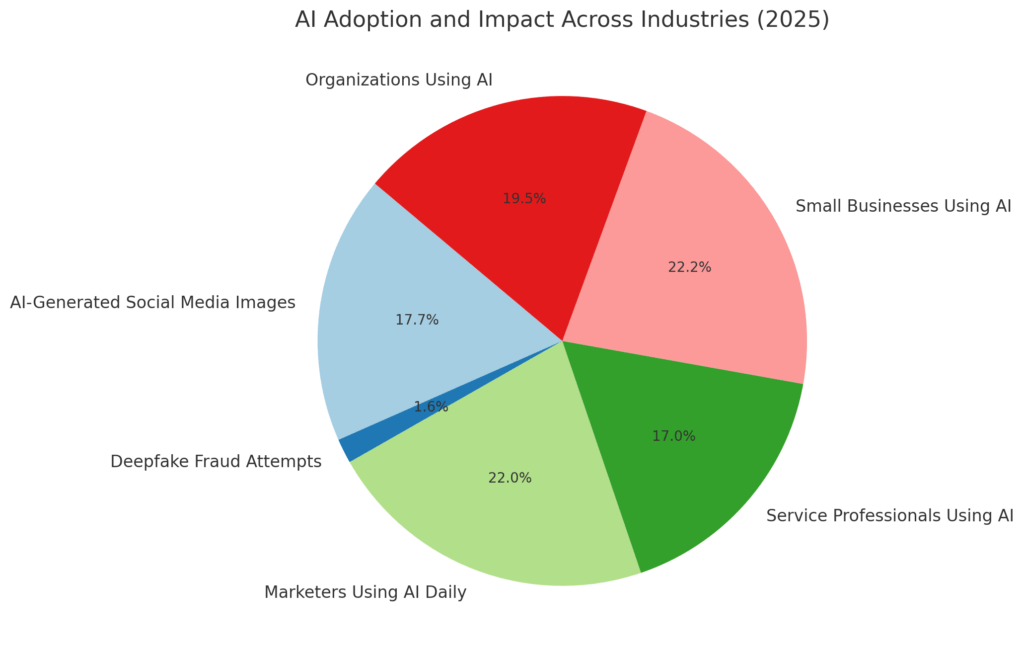
AI-GENERATED CONTENT STATISTICS 2025 #6. Generative AI Market Projected at $62.72 Billion in 2025
The generative AI industry is experiencing exponential growth, driven by demand for AI-powered content creation, chatbots, and digital assistants. Companies are investing heavily in AI models that can generate text, images, music, and even code. This growth will lead to increased competition among AI startups and major tech firms, accelerating advancements in natural language processing and creativity. However, ethical and regulatory concerns surrounding copyright, misinformation, and AI bias could slow adoption. Businesses that successfully integrate generative AI into their workflows will gain a productivity edge, reducing reliance on human labor for repetitive creative tasks. The rise of AI-generated content also challenges traditional creative industries, forcing professionals to adapt or risk losing relevance. In the coming years, generative AI will become a standard tool across multiple industries, from entertainment to journalism and education.
AI-GENERATED CONTENT STATISTICS 2025 #7. 47% of U.S. Executives See AI Boosting Productivity
AI’s ability to automate complex tasks and analyze vast datasets is reshaping business operations. Nearly half of U.S. executives recognize AI’s potential to enhance productivity by reducing human workload and streamlining decision-making. Companies implementing AI-driven automation report cost savings and improved efficiency, especially in customer service and supply chain management. However, concerns about data security, workforce displacement, and ethical AI implementation remain. Businesses that adopt AI responsibly will benefit from increased innovation and agility in competitive markets. Executives will need to prioritize AI literacy among employees to fully harness its capabilities. Moving forward, AI’s role in the workplace will continue to expand, making it a fundamental driver of business growth.
AI-GENERATED CONTENT STATISTICS 2025 #8. 89% of Small Businesses Utilize AI Tools
Small businesses are leveraging AI to automate marketing, customer service, and administrative tasks, enabling them to compete with larger corporations. AI-powered chatbots, predictive analytics, and automated content creation tools are reducing operational costs while improving efficiency. This widespread adoption indicates that AI is no longer exclusive to tech giants but is accessible to businesses of all sizes. However, some small business owners struggle with AI implementation due to a lack of technical expertise or budget constraints. As AI tools become more affordable and user-friendly, even micro-businesses will benefit from automation. The challenge will be maintaining a human touch in customer interactions while maximizing AI-driven efficiency. In the future, AI will likely become an indispensable tool for small business growth, driving increased adoption across industries.
AI-GENERATED CONTENT STATISTICS 2025 #9. 8 Billion AI-Powered Voice Assistants by 2025
The proliferation of AI-powered voice assistants like Siri, Alexa, and Google Assistant suggests a future where voice interaction is a dominant form of digital engagement. This shift will impact industries such as e-commerce, customer service, and accessibility technology. Businesses that optimize their platforms for voice search will gain a competitive advantage as voice-based shopping and commands become more common. However, concerns over data privacy and AI surveillance will grow as these assistants collect vast amounts of personal information. Stricter regulations may be necessary to ensure ethical AI use and consumer trust. The convenience of AI voice assistants will drive further adoption, but users must remain cautious about data security. As AI continues to evolve, voice technology will likely become even more personalized and integrated into daily life.
AI-GENERATED CONTENT STATISTICS 2025 #10. 88% of Marketers Use AI in Daily Roles
AI has become an essential tool for marketers, automating everything from ad targeting to social media content creation. The ability to analyze consumer behavior and generate personalized content in real-time gives brands a competitive edge. However, heavy reliance on AI-generated marketing could lead to over-saturation of automated content, making differentiation more challenging. Ethical considerations, such as AI bias in ad targeting and data privacy, will shape the future of AI-driven marketing. Companies that blend AI efficiency with human creativity will stand out in crowded digital spaces. As AI continues to evolve, its role in marketing will expand beyond automation to include predictive analytics and real-time content adaptation. In the future, AI will likely play an even bigger role in strategic decision-making, helping brands anticipate consumer trends before they emerge.
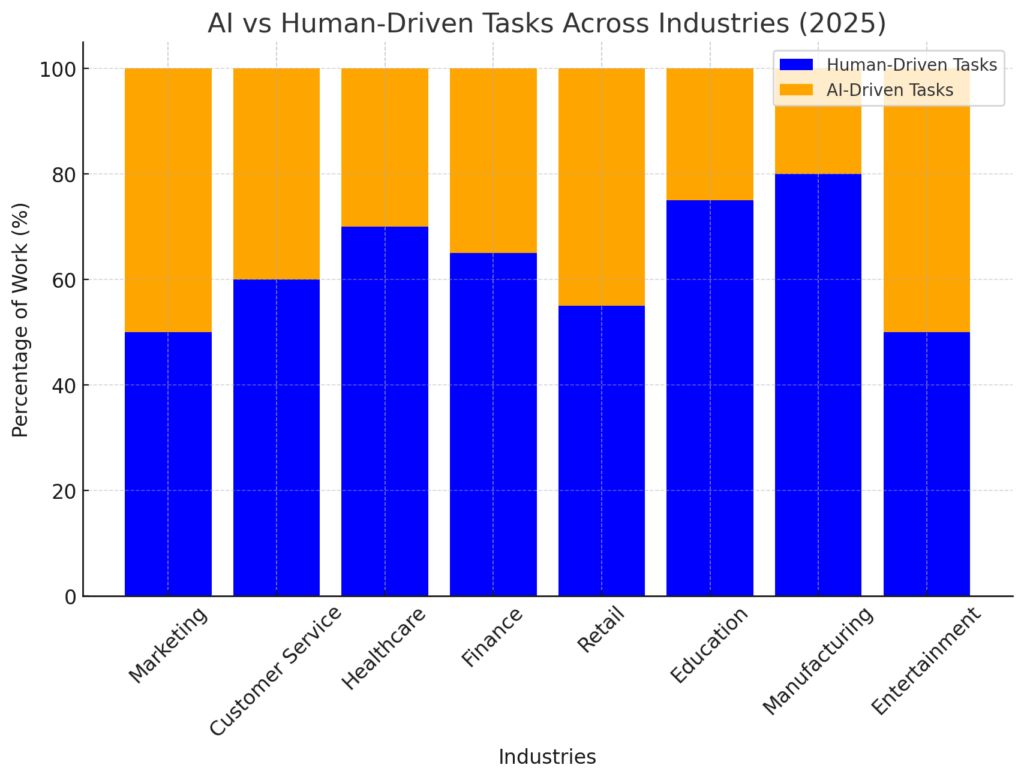
AI-GENERATED CONTENT STATISTICS 2025 #11. 68% of Service Professionals Use AI for Content Creation
AI-powered tools are becoming indispensable for service professionals, streamlining content creation, email automation, and customer communications. Many professionals use AI to generate reports, draft responses, and personalize client interactions efficiently. This shift allows businesses to handle a higher volume of customer inquiries while maintaining consistency in communication. However, the overuse of AI-generated content could reduce authenticity and personal engagement, which remain crucial in service industries. Businesses must strike a balance between AI automation and human touch to retain customer trust. Additionally, AI-driven tools may introduce biases in responses if not monitored properly, raising ethical concerns. Moving forward, AI is expected to further integrate with customer relationship management (CRM) systems, enhancing predictive analytics and automated personalization.
AI-GENERATED CONTENT STATISTICS 2025 #12. 92% of Fortune 500 Companies Leverage OpenAI’s Technology
The overwhelming adoption of OpenAI’s tools by Fortune 500 companies reflects the growing dependence on AI for business operations. From automating workflows to enhancing customer experiences, these enterprises are using AI to maintain competitive advantages. OpenAI’s language models are particularly useful for generating reports, summarizing data, and creating automated customer interactions. However, this level of reliance also raises concerns about data privacy, model accuracy, and over-centralization of AI power. As AI becomes more embedded in corporate decision-making, companies will need to ensure transparency in how AI-generated insights are used. The dominance of a few AI providers like OpenAI could also limit market diversity, prompting regulatory scrutiny. In the long run, AI’s integration into major corporations will shape business strategies across all industries, making AI literacy a required skill for future executives.
AI-GENERATED CONTENT STATISTICS 2025 #13. AI Market to Grow by 38% in 2025
The rapid expansion of the AI market indicates increasing investments in AI-driven automation, deep learning, and generative models. As more industries recognize AI’s potential, funding for research and development is surging. Startups and established tech giants alike are racing to develop AI-powered solutions for everything from healthcare diagnostics to legal document automation. However, as AI adoption grows, so do ethical and regulatory concerns regarding bias, misinformation, and job displacement. Governments worldwide are working to establish AI policies to ensure responsible development and deployment. Businesses that fail to adopt AI risk being outpaced by competitors, making AI integration a necessity rather than an option. Looking ahead, AI will likely become embedded in everyday life, driving innovations that reshape industries across the board.
AI-GENERATED CONTENT STATISTICS 2025 #14. AI-Generated Content Comprises 99% of Internet Material by 2030
The internet is rapidly transitioning to AI-generated content, raising concerns about originality and the future of human-created material. While AI-generated blogs, videos, and images improve efficiency, they also contribute to a flood of synthetic media, making it harder to verify authenticity. This shift could devalue traditional journalism, artistic creation, and independent thought unless strong verification mechanisms are in place. Search engines and social media platforms may struggle to filter AI-generated “noise” from meaningful content, leading to misinformation challenges. On the positive side, AI can democratize content creation, allowing individuals and small businesses to produce high-quality materials without expensive resources. However, audiences may become increasingly skeptical of online information, requiring platforms to implement AI detection tools. In the future, AI watermarking and regulatory oversight may be necessary to distinguish between human and AI-created content.
AI-GENERATED CONTENT STATISTICS 2025 #15. AI in Digital Commerce to Improve Customer Satisfaction by 25%
AI is revolutionizing digital commerce by providing personalized recommendations, chat-based customer service, and automated order processing. With machine learning algorithms predicting consumer preferences, businesses can offer highly tailored shopping experiences. This level of personalization increases engagement and customer loyalty, leading to higher sales conversions. However, over-reliance on AI could lead to less human interaction, which some customers still value. Ethical concerns regarding consumer data collection and AI-driven pricing strategies may also require stronger privacy protections. Companies that use AI responsibly will gain a competitive edge in e-commerce, balancing efficiency with human oversight. In the coming years, AI-powered virtual shopping assistants and predictive analytics will further transform online retail experiences.
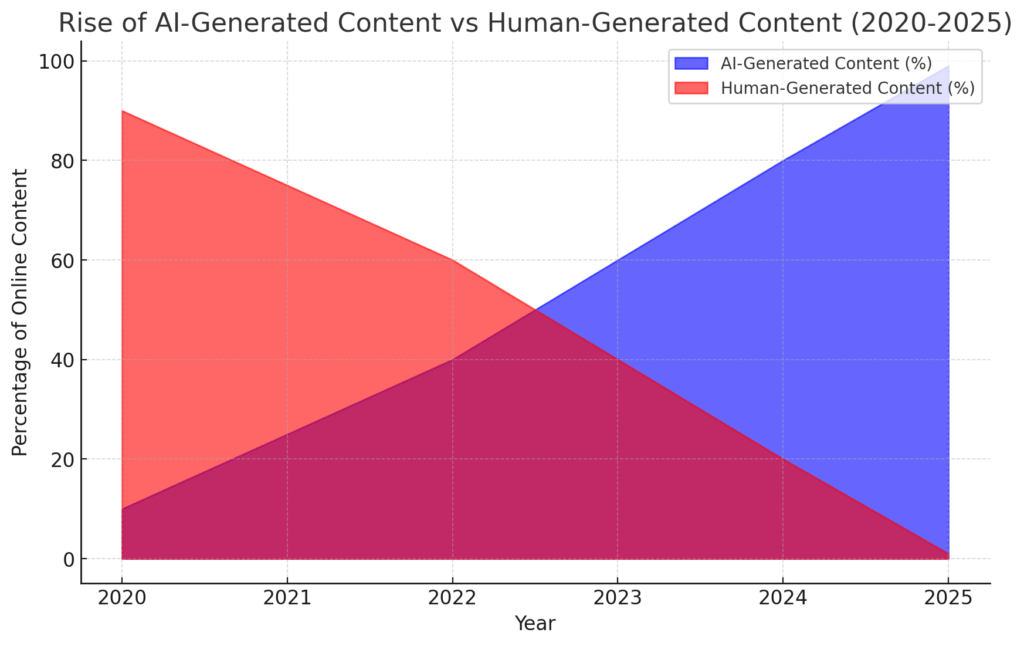
AI-GENERATED CONTENT STATISTICS 2025 #16. AI-Generated ‘Slop’ Increasingly Populates the Internet
The internet is becoming saturated with low-quality AI-generated content, often referred to as “slop,” which threatens the integrity of online information. Many content farms and websites use AI to mass-produce articles with little originality or value, cluttering search engine results. This trend makes it harder for users to find reliable, high-quality content, reducing trust in digital media. Search engines are already adjusting algorithms to prioritize human-created content, but distinguishing between AI and human writing is becoming increasingly difficult. Misinformation and SEO spam are growing concerns, prompting tech companies to develop stronger AI detection methods. If left unchecked, the rise of AI-generated “slop” could erode the usefulness of online research and journalism. Future regulations may enforce transparency in AI-generated content to maintain credibility in digital spaces.
AI-GENERATED CONTENT STATISTICS 2025 #17. 92% of UK University Students Use AI Tools
AI adoption among university students is nearly universal, highlighting the role of AI in education. From research assistance to AI-generated study notes, students are integrating AI tools into their academic routines. While AI helps streamline learning, it also raises concerns about academic integrity and over-reliance on machine-generated information. Universities are struggling to update policies to address AI-assisted plagiarism and originality verification. Some institutions have begun incorporating AI literacy into their curricula, preparing students for AI-driven workplaces. Ethical debates surrounding AI’s role in education will continue, particularly regarding assessment fairness and critical thinking development. As AI tools become more sophisticated, educators will need to find ways to integrate them responsibly while preserving independent learning skills.
AI-GENERATED CONTENT STATISTICS 2025 #18. AI-Generated Content Affects Search Engine Quality
The increasing prevalence of AI-generated content is reshaping how search engines rank and display information. While AI can optimize content for SEO, it can also lead to a flood of auto-generated articles that prioritize keyword stuffing over genuine insights. Google and other search engines are adapting algorithms to detect and penalize low-quality AI content, but distinguishing between human and AI-generated material remains a challenge. This trend impacts digital marketing strategies, forcing content creators to focus on originality and value rather than mass production. The rise of AI-generated misinformation also requires stronger content moderation efforts. Future search engine updates may incorporate AI detection models to ensure search results maintain credibility. Ultimately, balancing AI efficiency with content authenticity will be critical to maintaining search engine reliability.
AI-GENERATED CONTENT STATISTICS 2025 #19. AI Adoption in Customer Service Enhances Efficiency
AI is transforming customer service by automating responses, reducing wait times, and improving issue resolution. Chatbots and virtual assistants allow businesses to provide 24/7 support, improving accessibility and customer satisfaction. However, AI’s inability to handle complex emotional interactions remains a limitation, requiring human intervention in sensitive cases. The challenge for businesses is to integrate AI without sacrificing personalized service, as excessive automation can feel impersonal. As AI-powered chatbots become more advanced, their ability to understand customer emotions and context will improve. Ethical concerns surrounding data privacy and AI decision-making transparency will continue to shape customer service policies. In the future, AI-driven customer support will likely become more nuanced, blending automation with human empathy for a seamless experience.
AI-GENERATED CONTENT STATISTICS 2025 #20. AI-Powered Tools Assist in Academic Research
AI is revolutionizing academic research by streamlining data analysis, literature reviews, and hypothesis generation. Researchers can now use AI to process vast amounts of information in a fraction of the time, accelerating scientific discovery. However, concerns about AI-generated bias and the accuracy of AI-summarized findings remain critical challenges. Universities and research institutions are developing AI ethics guidelines to ensure responsible use in academia. AI-powered plagiarism detection is also becoming more advanced, helping maintain integrity in scholarly work. As AI continues to evolve, it will likely play a larger role in hypothesis testing and predictive modeling. In the future, AI could become an essential partner in research, augmenting human expertise while requiring careful oversight.
The Future of AI-Generated Content: Balancing Innovation and Responsibility
AI-generated content is rapidly transforming industries, from marketing and social media to academia and customer service. While its efficiency and scalability offer significant advantages, the increasing reliance on AI also raises concerns about misinformation, authenticity, and ethical responsibility. As AI-generated media becomes nearly indistinguishable from human-created content, businesses and policymakers must establish safeguards to ensure transparency and trust. Search engines and digital platforms will continue adapting to filter AI-generated “slop,” while professionals in creative and analytical fields will need to refine their expertise to work alongside AI rather than be replaced by it. Education systems must also address the role of AI in learning, ensuring that students develop critical thinking skills even as they use AI-powered tools. The future of AI-generated content depends on finding the right balance between innovation and human oversight, ensuring that technology enhances rather than undermines the quality and integrity of digital content.
Sources:
- https://www.forbes.com/sites/bernardmarr/2025/03/10/15-mind-blowing-ai-statistics-everyone-must-know-about-now/
- https://www.forbes.com/sites/bernardmarr/2025/03/10/15-mind-blowing-ai-statistics-everyone-must-know-about-now/
- https://www.nu.edu/blog/ai-statistics-trends/
- https://www.nu.edu/blog/ai-statistics-trends/
- https://planable.io/blog/ai-statistics/
- https://www.sequencr.ai/insights/key-generative-ai-statistics-and-trends-for-2025
- https://www.amplifai.com/blog/generative-ai-statistics
- https://www.teneo.ai/blog/ai-ascendancy-unveiling-top-ai-statistics-and-trends-for-2025
- https://www.teneo.ai/blog/ai-ascendancy-unveiling-top-ai-statistics-and-trends-for-2025
- https://www.surveymonkey.com/mp/ai-marketing-statistics/
- https://www.salesforce.com/news/stories/generative-ai-statistics/
- https://www.sequencr.ai/insights/key-generative-ai-statistics-and-trends-for-2025
- https://www.teneo.ai/blog/ai-ascendancy-unveiling-top-ai-statistics-and-trends-for-2025
- https://en.wikipedia.org/wiki/Dead_Internet_theory
- https://www.teneo.ai/blog/ai-ascendancy-unveiling-top-ai-statistics-and-trends-for-2025
- https://www.theguardian.com/global/commentisfree/2025/jan/08/ai-generated-slop-slowly-killing-internet-nobody-trying-to-stop-it
- https://www.theguardian.com/education/2025/feb/26/uk-universities-warned-to-stress-test-assessments-as-92-of-students-use-ai
- https://en.wikipedia.org/wiki/Dead_Internet_theory
- https://www.amplifai.com/blog/generative-ai-statistics
- https://en.wikipedia.org/wiki/Generative_artificial_intelligence

